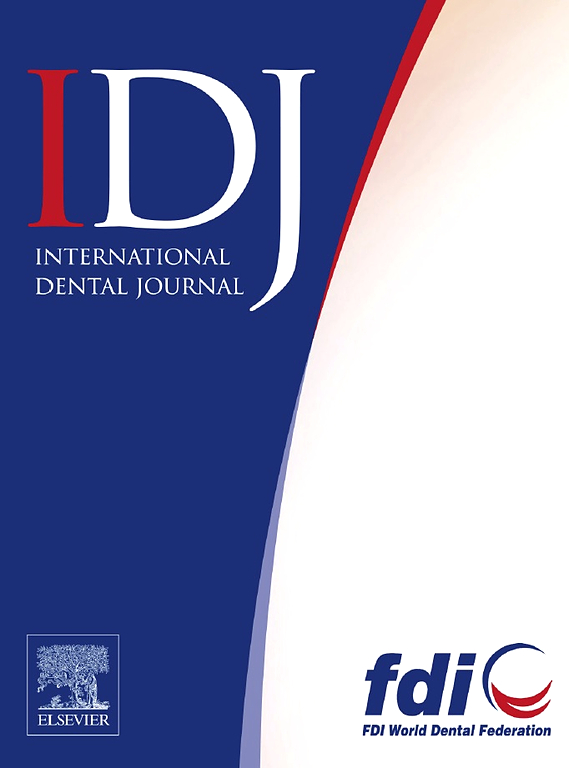In Vitro Comparison of the Performance of Hydrophilic and Conventional Hydrophobic Resin-Based Fissure Sealants
IF 3.2
3区 医学
Q1 DENTISTRY, ORAL SURGERY & MEDICINE
引用次数: 0
Abstract
Background
Hydrophilic sealants were developed to overcome hydrophobic sealant moisture sensitivity; however, there is still a limited understanding of their performance. This study aimed to compare microshear bond strength, penetration depth, and microleakage of hydrophilic UltraSeal XT hydro and hydrophobic Clinpro resin-based sealants placed in various surface conditions.
Methods
Seventy-two enamel slices and 60 molars were randomly assigned into two groups: Group 1 UltraSeal XT hydro and Group 2 Clinpro, which were further subdivided into three groups based on the enamel surface conditions (dry, slightly moist, and saliva-contaminated). After applying sealant and undergoing 5000 thermocycling cycles, microshear bond strength was tested. Additionally, penetration depth and microleakage were evaluated under a light microscope after staining with 50% silver nitrate solution.
Results
Group 1 demonstrated significantly higher microshear bond strength than Group 2 across all experimental conditions (P < .001). Both sealants showed the highest microshear bond strengths under dry conditions, followed by slightly moist and saliva-contaminated conditions (P < .001). The penetration depth between the two sealant types was comparable within each surface condition. However, both sealants showed significantly deeper penetration on dry enamel surfaces compared to slightly moist and saliva-contaminated surfaces (P < .001). Similarly, both sealants exhibited significantly less microleakage on dry enamel surfaces compared to slightly moist and saliva-contaminated surfaces (P < .001). While the mean microleakage value was similar between the two sealants under dry and saliva-contaminated conditions, Group 1 showed significantly lower microleakage than Group 2 under moist conditions (P < .001).
Conclusion
The hydrophilic UltraSeal XT hydro sealant exhibited superior bond strength compared to the hydrophobic Clinpro sealant across all surface conditions. On slightly moist surfaces, UltraSeal XT hydro showed significantly lower microleakage than Clinpro. Both sealants exhibited superior sealing and retentive ability on dry enamel surfaces compared to the other surfaces.
亲水与常规疏水树脂基裂缝密封胶的体外性能比较
为了克服疏水密封胶的水分敏感性,研制了亲水密封胶;然而,人们对其性能的了解仍然有限。本研究旨在比较不同表面条件下亲水性UltraSeal XT水基和疏水性Clinpro树脂基密封剂的微剪切结合强度、渗透深度和微泄漏情况。方法将72片牙釉质和60颗磨牙随机分为两组:1组UltraSeal XT hydro和2组Clinpro,根据牙釉质表面情况(干燥、微湿和唾液污染)再分为3组。在涂上密封胶并进行5000次热循环后,测试了微剪切粘结强度。50%硝酸银溶液染色后,光镜下观察穿透深度和微渗漏。结果在所有实验条件下,1组的微剪切粘接强度均显著高于2组(P <;措施)。两种密封胶在干燥条件下的微剪切强度最高,其次是轻微潮湿和唾液污染的条件(P <;措施)。在不同的表面条件下,两种密封胶的渗透深度具有可比性。然而,这两种密封剂在干燥的牙釉质表面上的渗透程度明显高于轻微潮湿和唾液污染的牙釉质表面(P <;措施)。同样,两种密封剂在干燥的牙釉质表面上的微渗漏明显少于轻微潮湿和唾液污染的表面(P <;措施)。两种密封剂在干燥和唾液污染条件下的平均微泄漏值相似,但在潮湿条件下,1组的微泄漏值显著低于2组(P <;措施)。结论与疏水性Clinpro密封胶相比,亲水UltraSeal XT在所有表面条件下都具有更好的粘结强度。在轻微潮湿的表面上,UltraSeal XT hydro的微泄漏率明显低于Clinpro。与其他表面相比,这两种密封剂在干燥的牙釉质表面表现出优越的密封和保持能力。
本文章由计算机程序翻译,如有差异,请以英文原文为准。
求助全文
约1分钟内获得全文
求助全文
来源期刊

International dental journal
医学-牙科与口腔外科
CiteScore
4.80
自引率
6.10%
发文量
159
审稿时长
63 days
期刊介绍:
The International Dental Journal features peer-reviewed, scientific articles relevant to international oral health issues, as well as practical, informative articles aimed at clinicians.
 求助内容:
求助内容: 应助结果提醒方式:
应助结果提醒方式:


